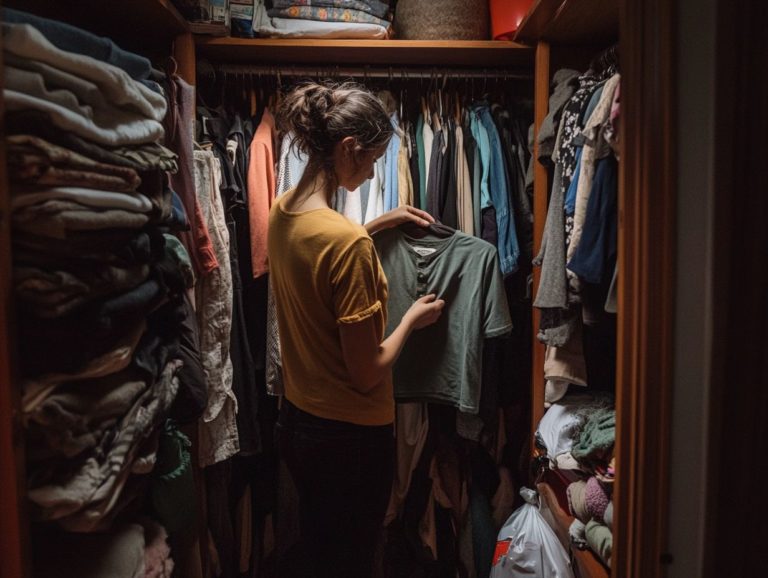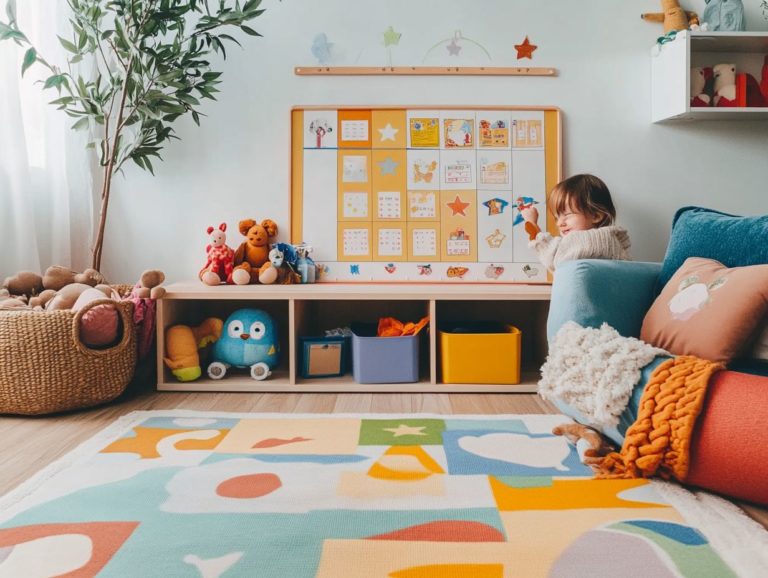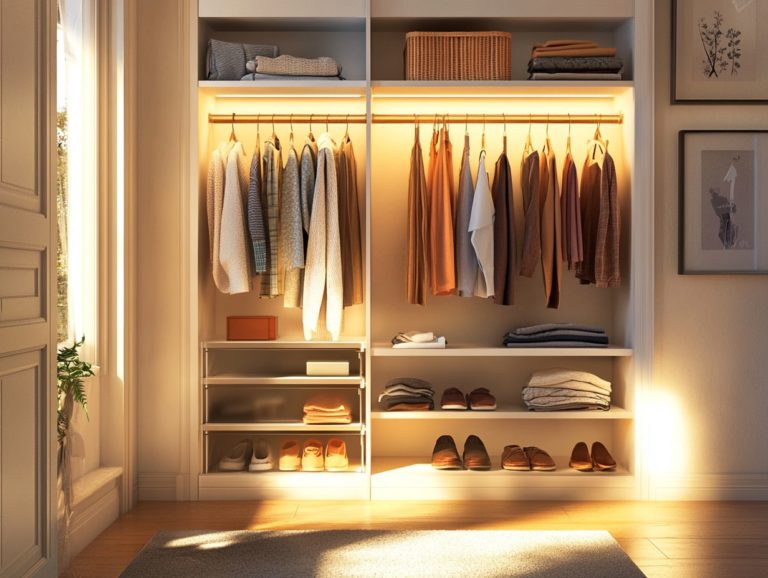The 5-Step Closet Decluttering Checklist
Is your closet bursting at the seams, leaving you feeling a bit frazzled? A cluttered space can create unnecessary stress and make it difficult to locate what you need, especially when it comes to organizing your closet.
This guide presents a simple yet effective 5-step checklist designed to help you evaluate your closet situation, set achievable goals, and sort through your clothing easily, making decluttering more manageable.
This guide explores the benefits of a decluttered closet and provides valuable tips for maintaining your newly organized space, including effective ways to keep your items organized and donation strategies.
Get ready to transform your space and welcome a sense of clarity into your life as you learn to tidy up and make the most of your space!
Contents
- Key Takeaways:
- 1. Assess Your Current Closet Situation
- 2. Set a Realistic Goal
- 3. Sort Through Your Clothes
- 4. Organize and Maximize Your Space
- 5. Maintain Your Newly Decluttered Closet
- Why Is It Important to Declutter Your Closet?
- Frequently Asked Questions
- What is The 5-Step Closet Decluttering Checklist?
- What are the 5 steps in The 5-Step Closet Decluttering Checklist?
- How long does it take to complete The 5-Step Closet Decluttering Checklist?
- Do I need any special tools or supplies to use The 5-Step Closet Decluttering Checklist?
- Can The 5-Step Closet Decluttering Checklist be applied to any type of closet?
- How often should I use The 5-Step Closet Decluttering Checklist?
Key Takeaways:

- Assess your closet situation before starting the decluttering process to create a plan that works for your specific needs.
- Set realistic goals to help you stay motivated and on track during your decluttering journey.
- Sort through your clothes and remove items you no longer need or wear to maximize your closet space, keeping it organized.
1. Assess Your Current Closet Situation
Assessing your current closet situation is a pivotal first step towards a clutter-free home. This allows you to pinpoint areas needing decluttering and organization, setting the stage for making the most of your space and thoughtfully donating unneeded items.
Take a moment to evaluate not just the volume of closet clutter but also how well your current ways to keep items organized function, including shelving and drawer organizers. Consider consulting the essential checklist for minimalist wardrobes to determine what items you genuinely need and use regularly.
This process requires a close look at various categories of items, such as seasonal clothing that may be occupying precious space. For instance, you might find summer shorts still lingering in your winter wardrobe, leaving little room for heavier jackets you re currently wearing.
It’s also crucial to evaluate the effectiveness of your shoe racks or bins, as these often turn into catch-alls for forgotten footwear, much like children s toys or other belongings.
By categorizing your belongings, you streamline your closet and create a system that makes it easier to locate what you need. Remember, a well-organized closet begins with a thoughtful evaluation of what truly deserves a place on your shelves and how to properly label your storage.
2. Set a Realistic Goal
Setting a realistic goal for your decluttering journey is essential. This gives you a clear target to strive for, ensuring your space management and cleaning tasks remain achievable.
To create specific, measurable, and time-bound goals, assess the size of your closet and inventory the various items you have. For example, you might choose to tackle shoes on the first day and clothing on the next, breaking the workload into manageable portions. Understanding the role of minimalism in closet decluttering can also guide your approach.
It s wise to allocate specific time blocks, such as dedicating 30 minutes each day, so that decluttering doesn t become overwhelming. By considering your available time and the quantity of belongings, you can develop a schedule that fosters progress while keeping your motivation high throughout the process.
3. Sort Through Your Clothes
Sorting through your clothes is a crucial step in decluttering your wardrobe and enhancing your home cleaning strategy. It s all about categorizing items, both sentimental and practical, empowering you to decide what to keep, donate, or discard.
Begin by dividing your pieces into distinct categories: everyday wear, seasonal items, and formal attire. As you sift through each garment, consider how often you wear it and the memories attached. You might also want to assess furniture or other belongings in your space. Utilizing the Marie Kondo method for closet decluttering streamlines the process and helps identify items that no longer serve a purpose.
While assessing emotional attachments, you may confront feelings tied to past experiences linked to certain clothes. Keep things organized with a checklist or designated bins. Label them for easy access, making it clear which are keepers and which items to recycle or discard. Knowing when to declutter your closet can also streamline this process.
4. Organize and Maximize Your Space
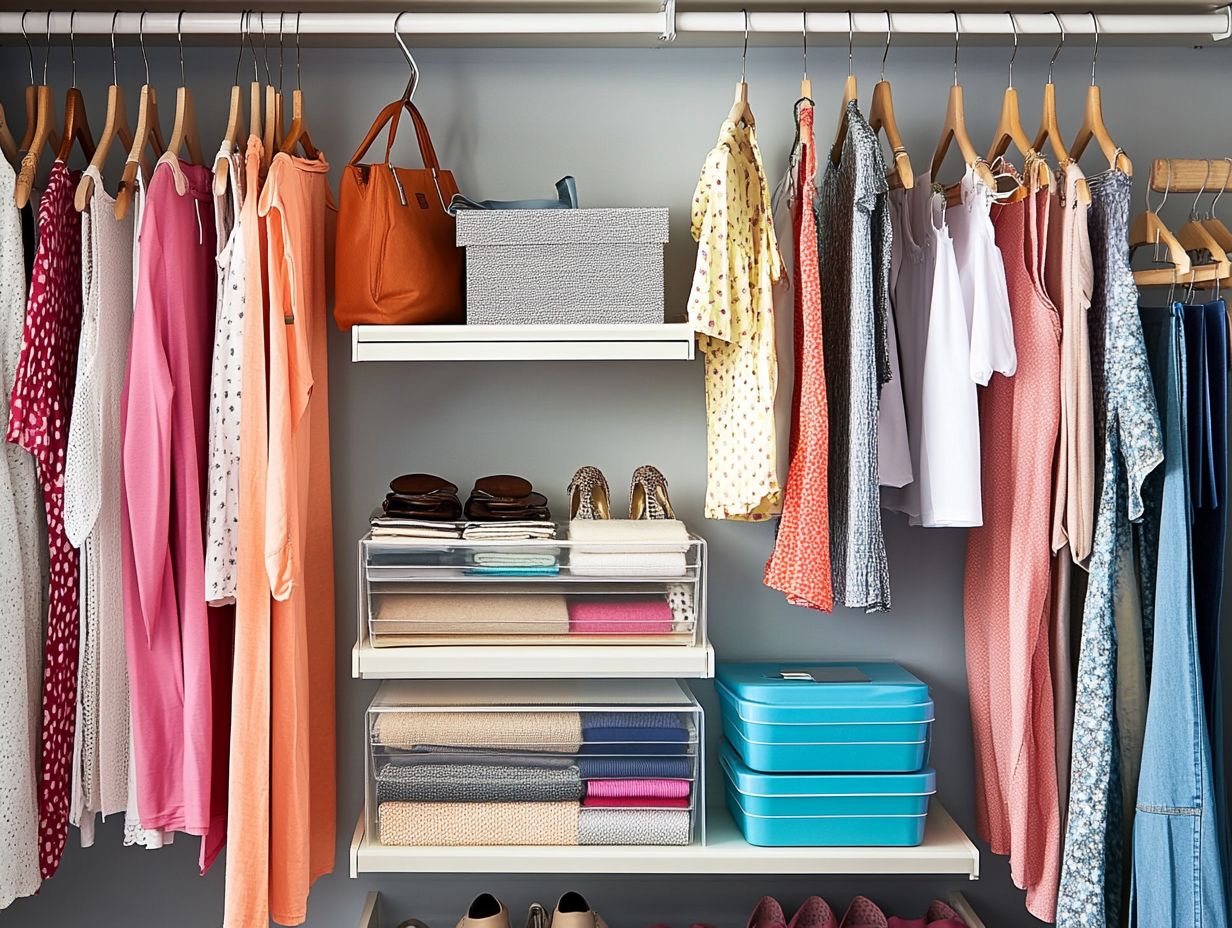
Transform your closet by organizing and maximizing your space with tailored storage solutions! Each item should be easily accessible, contributing to overall tidiness.
Utilizing techniques like drawer organizers and shelving enhances functionality, especially for kitchen decluttering and home office setups. To streamline your wardrobe, consider following the ultimate closet decluttering guide by categorizing your clothing into groups such as work attire, casual wear, and accessories. This simple division makes it a breeze to find what you need.
For children s toys, use clear bins labeled with images or words for easy identification. Neatly folding linens and storing them on dedicated shelves helps maintain a tidy linen closet that complements your organizing efforts. Store seasonal items in labeled bins placed high, freeing up lower space for everyday essentials.
By adopting these tailored storage strategies, create an organized, functional area that meets your specific storage demands across all sections of your home.
5. Maintain Your Newly Decluttered Closet
Maintaining your newly decluttered closet requires a consistent cleaning schedule and a rotation system for seasonal items. Enjoy the long-term benefits of a clutter-free home!
Set aside time every few months to sort through your items and check for expired food in the refrigerator. Make it a point to donate or store things you don’t use frequently. For those looking for more organization tips, tips for decluttering a small closet space can be invaluable. A rotation system for seasonal items makes accessing what you need easier while keeping your closet organized.
Practice mindful shopping habits evaluate each potential purchase for its necessity and whether it might contribute to clutter. This disciplined approach not only helps maintain a tidy space but also fosters a mindset focused on sustainability and intentional living, minimizing emotional attachment to excess items.
Start sorting today and create your dream closet!
Why Is It Important to Declutter Your Closet?
Decluttering your closet is more than just looking nice; it plays a vital role in enhancing your overall well-being. It contributes to a more tranquil living space. Don t wait! Reducing stress and organizing efficiently can transform your life right now!
By promoting efficient organization, you can free yourself from the emotional attachments to items that no longer serve you, like outdated clothing or children s toys. This intentional process cultivates improved mental clarity, which means being able to think clearly and make decisions easily.
It also boosts your productivity by ensuring you can quickly access essentials like utensils or paperwork. With a neatly organized space, accessing your items becomes a breeze, aiding in your cleaning schedule and time management.
Shedding the weight of unused possessions often leads to profound emotional relief, creating valuable room for personal growth and rejuvenation. A well-maintained closet can transform your daily routines, making your mornings smoother and more enjoyable. It’s important to understand the top 10 closet decluttering myths debunked, ultimately reducing the stress of daily choices.
Embracing the practice of decluttering contributes to a tranquil living space. The peace of mind you gain fosters a harmonious lifestyle. It encourages mindfulness and a deeper appreciation for what truly matters in your life, such as sustainable living and effective clutter management.
What Are the Benefits of a Decluttered Closet?
A decluttered closet brings numerous benefits. You ll experience improved organization, reduced stress levels, and enhanced efficiency in locating items, whether in your home office or living room.
This transformation not only contributes to a more orderly home but also fosters a more positive living experience. It promotes healthier habits in your kitchen and beyond.
By streamlining your closet s contents, you reclaim valuable time that would otherwise be lost searching for misplaced shoes or that perfect outfit. This newfound efficiency boosts your productivity in daily life.
You can concentrate on what truly matters arriving at work on time or savoring quality moments with family.
As clutter fades away, a soothing sense of calm envelops your household. This makes it more enjoyable for everyone, including children and family members. Ultimately, this fosters a harmonious environment that promotes well-being and encourages both creativity and relaxation.
How Can Decluttering Your Closet Improve Your Mental Health?
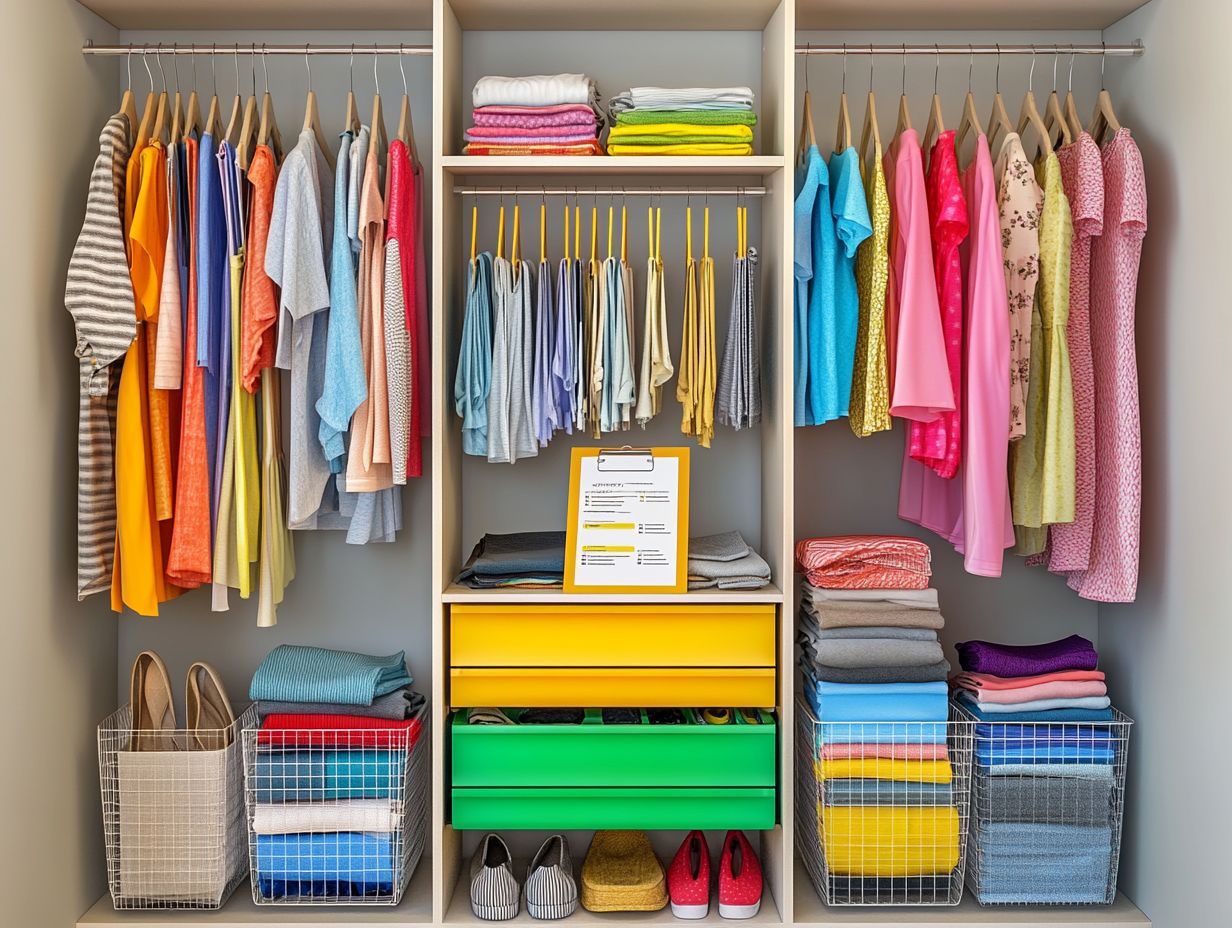
Decluttering your closet can significantly elevate your mental well-being by alleviating the stress and anxiety tied to disorganization. This fosters an organized mind and allows you to cultivate a serene space, free from emotional attachments to unnecessary items.
This transformation goes beyond mere aesthetics; it nurtures a sense of clarity and mental refreshment. When you confront the chaos of a cluttered environment, it often reflects an internal disarray, making it challenging to focus on what truly matters.
By taking the initiative to purge old clothing and items that no longer serve a purpose, you may experience a profound sense of accomplishment. This helps you regain control over your surroundings, positively affecting your kitchen and living areas.
For instance, a tidy closet not only streamlines your daily choices but also contributes to a more organized mind. This minimizes the mental clutter that fuels feelings of anxiety and overwhelm in all aspects of your home management.
Have you ever felt overwhelmed by your belongings? If so, start decluttering today for a happier home!
What Are Some Common Mistakes People Make When Decluttering Their Closet?
Many individuals stumble into common pitfalls when decluttering their closets. They often cling to items due to emotional ties or neglect simple organization methods, which can also apply to furniture and electronics. This can significantly impede the decluttering journey.
Indecisiveness can sneak in, making it tough to determine what should stay and what should go. Without a clear plan, tackling this task can be challenging. To navigate these obstacles, setting specific goals is essential. For instance, deciding to remove a certain number of items creates a tangible target to aim for.
Embracing the “one-year rule” can also streamline your decision-making process. If you haven’t worn an item in the past year, it’s time for a reassessment. Investing in useful storage options like labeled bins or organizers will help ensure that your space remains tidy long after the initial decluttering effort. Exploring the benefits of a decluttered closet makes it easier to maintain over time.
How Often Should You Declutter Your Closet?
Establishing a regular decluttering schedule is key to keeping your closet organized and free of clutter. Aim to assess it at least seasonally, especially when swapping out seasonal items or evaluating unworn clothing.
Your daily habits are crucial in determining how often you should engage in this process. For instance, if you frequently bring new pieces into your wardrobe, a monthly review could be beneficial to keep that influx in check.
Set reminders on your calendar or use organizational apps to help maintain this routine. This will ensure the task doesn t slip through the cracks of your busy schedule. Recognizing personal triggers for clutter, like holidays or special events, can help you plan assessments better and lead to a consistently tidy space.
What Are Some Tips for Maintaining a Decluttered Closet?
To maintain a decluttered closet, it s essential to implement effective organization tips, establish a cleaning schedule, and regularly assess your items. This ensures your space remains efficient and free from clutter.
Incorporating mindful shopping practices can significantly reduce the influx of unnecessary items. Before making a purchase, take a moment to evaluate whether the item will genuinely enhance your wardrobe or simply contribute to the chaos. For more effective strategies, consider exploring the top 5 closet decluttering techniques.
Effective organization techniques, such as grouping clothing by season or category, will make it easier to find what you need. Devote a few minutes each week to tidy up; this reinforces discipline and transforms the task into something manageable rather than overwhelming.
This consistency not only promotes a tidy environment but also provides clarity, allowing for a more enjoyable dressing experience each day.
Frequently Asked Questions
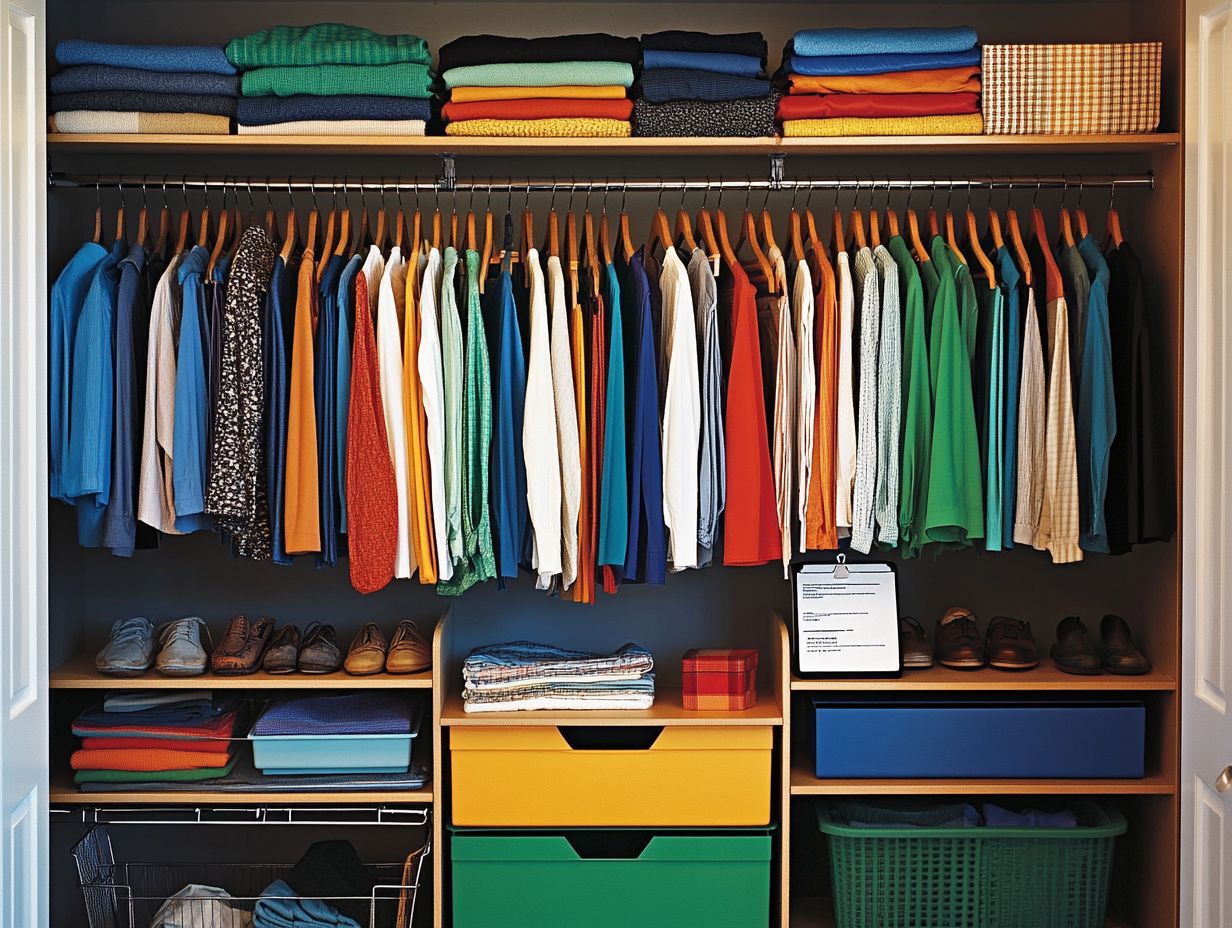
What is The 5-Step Closet Decluttering Checklist?
The 5-Step Closet Decluttering Checklist is a systematic approach to organizing and decluttering your closet, resulting in a more functional and visually appealing space.
What are the 5 steps in The 5-Step Closet Decluttering Checklist?
- Set a goal
- Empty your closet
- Sort and categorize items
- Assess and purge
- Organize and maintain
How long does it take to complete The 5-Step Closet Decluttering Checklist?
The time it takes to complete The 5-Step Closet Decluttering Checklist will vary depending on the size and current state of your closet. However, it can typically be completed in a few hours to a full day.
Do I need any special tools or supplies to use The 5-Step Closet Decluttering Checklist?
No, The 5-Step Closet Decluttering Checklist can be completed with basic household items such as garbage bags, boxes, and hangers. However, having storage solutions like bins and baskets can make the organizing process more efficient.
Can The 5-Step Closet Decluttering Checklist be applied to any type of closet?
Yes, The 5-Step Closet Decluttering Checklist can be applied to any type of closet, whether it’s a small reach-in closet or a large walk-in closet. The steps are adaptable to fit the specific needs and size of your closet.
How often should I use The 5-Step Closet Decluttering Checklist?
The 5-Step Closet Decluttering Checklist helps you keep your closet organized. Use it at least once a year to maintain a neat space.
If your closet feels cluttered, don t hesitate to refresh it. Enjoy the benefits of a tidy and functional closet!

